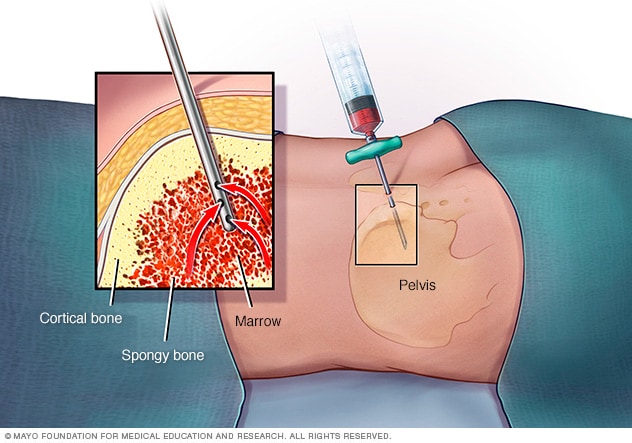诊断
用于诊断霍奇金淋巴瘤的检查和医疗程序包括:
根据您的具体情况,还有可能进行其他检测和程序。
Blood tests
Blood tests can sometimes show whether lymphoma cells are present. Blood tests may be used to test for viruses, including HIV, EBV, hepatitis B virus and hepatitis C virus. Blood tests also measure levels of lactate dehydrogenase (LDH), which is often higher in people with lymphoma.
Imaging tests
Imaging tests make pictures of the body. They can show the location and extent of Hodgkin lymphoma. Tests might include CT and positron emission tomography (PET) scans.
Biopsy
Your healthcare professional may suggest a lymph node biopsy or a biopsy of other tissue to look for cancer cells. A biopsy is a procedure to remove a sample of tissue for testing in a lab. A lymph node biopsy involves removing all or part of a lymph node. A sample may be taken from other parts of the body depending on symptoms and imaging test results. In the lab, tests may show whether you have Hodgkin lymphoma.
Bone marrow aspiration and biopsy
骨髓检查

骨髓检查
骨髓穿刺时,医疗护理专业人员使用一根细针抽出少量液体骨髓。通常从髋骨(骨盆)后方的某个部位抽取。通常会同时进行骨髓活检。这项医疗程序需要取出一小块骨组织和其中包含的骨髓。
Bone marrow aspiration and biopsy are procedures to collect cells from the bone marrow for testing. Bone marrow is the soft matter inside bones where blood cells are made. Bone marrow has a solid part and a liquid part.
In a bone marrow aspiration, a needle is used to collect a sample of the fluid. In a bone marrow biopsy, a needle is used to collect a small amount of the solid tissue. Most often, the samples are taken from the hip bone. The samples go to a lab for testing. For Hodgkin lymphoma, a healthcare professional may recommend this test only if blood counts are low and there isn't a clear reason for the low count.
霍奇金淋巴瘤的分期
根据您的检查结果对霍奇金淋巴瘤进行分期。分期有助于确定您状况的严重程度,并确定最适合您的治疗方法。
霍奇金淋巴瘤分为 1 至 4 期。数字越低,意味着淋巴瘤细胞仅累及一个或几个部位的淋巴结。早期癌症治愈的几率更大。随着淋巴瘤生长而累及身体的更多部位,分期数字也增加。数字越大,意味着癌症越晚期。
霍奇金淋巴瘤分期也可能包括字母 A 和 B。字母 A 意为您没有出现令人担心的淋巴瘤症状。字母 B 意为您有某些症状,例如发热或体重下降。
治疗
霍奇金淋巴瘤的治疗目标是破坏尽可能多的淋巴瘤细胞并缓解病情。最适合您的治疗方案取决于您的癌症类型和阶段、您的总体健康状况以及您的偏好。
化疗
化疗是一种利用化学物质杀死淋巴瘤细胞的药物治疗方法。化疗药物可通过血液到达身体几乎所有区域。化疗药物可以按药片形式服用,或通过臂内静脉给予,有时会同时使用这两种给药方法。
典型霍奇金淋巴瘤的治疗通常从化疗开始。化疗可能是所需的唯一治疗方法,也可能会与放射疗法联用。
对于结节性淋巴细胞为主的霍奇金淋巴瘤,通常会将化疗与癌细胞靶向药物(靶向治疗)和放射疗法联用。
化疗的副作用取决于为您提供的药物。常见的副作用包括恶心和脱发。可能出现严重的长期并发症,例如心脏病、肺部损害、生育问题和其他癌症。
放射疗法
放射疗法使用高能量束(例如,X 线和质子)来杀死癌细胞。在放射疗法中,您需要躺在手术台上,同时有一台大型机器在您周围移动,发出能量束对身体的特定部位进行精准照射。
对于霍奇金淋巴瘤的治疗,放射部位可能是受累淋巴结以及疾病可能扩散到的附近区域。通常会结合化疗进行。对于早期结节性淋巴细胞为主型霍奇金淋巴瘤患者,可能只需要进行放射疗法。
放射疗法的副作用包括疲劳和放射部位皮肤发红。其他副作用取决于放射部位。例如,颈部放射可能引起口腔干燥症和甲状腺功能减退症(甲减)等甲状腺问题。胸部放射可能引起心肺问题。
靶向治疗
癌症靶向治疗是一种利用药物攻击癌细胞中特定化学物质的治疗方法。通过阻断这些化学物质,靶向治疗可杀死癌细胞。靶向治疗常与化疗联合使用,治疗结节性淋巴细胞为主型霍奇金淋巴瘤。
对于经典型霍奇金淋巴瘤,靶向治疗在某些情况也可能是一种选择。
Immunotherapy
Immunotherapy for cancer is a treatment with medicine that helps the body's immune system kill cancer cells. The immune system fights off diseases by attacking germs and other cells that shouldn't be in the body. Cancer cells survive by hiding from the immune system. Immunotherapy helps the immune system cells find and kill the cancer cells.
Immunotherapy may be combined with chemotherapy or other medicines to treat Hodgkin lymphoma. Immunotherapy also may be used for refractory or relapsed Hodgkin lymphoma.
Side effects of immunotherapy may include fever, chills, weakness, dizziness, aches, nausea and vomiting. Rarely, some immunotherapy treatments can cause an allergic reaction.
骨髓移植
骨髓移植也称为干细胞移植,是一种用健康的干细胞替代患病骨髓的治疗方法,可帮助您长出新的骨髓。如果霍奇金淋巴瘤复发,或是其他治疗没有疗效,骨髓移植可能是一种选择。
在进行骨髓移植时,医生会取出您自身的造血干细胞,并将其冷冻和储存以供将来使用。随后,您将接受大剂量化疗和放射疗法,以破坏体内的癌细胞。最后,您的干细胞将被解冻并重新注入体内,以帮助重建健康的骨髓。
骨髓移植的副作用包括移植前化疗或放疗可能引起的副作用。此外,移植后感染的风险可能会增加。
Clinical trials
Clinical trials are studies of new treatments. These studies provide a chance to try the latest treatments. The risk of side effects might not be known. Ask your healthcare team if you might be able to be in a clinical trial.
Monitoring after treatment
After treatment is complete, you may have frequent follow-up appointments to see if the cancer has come back, known as a relapse. You may have repeat blood and imaging tests and, if needed, biopsies, to check for a relapse.
Side effects of treatment
Treatments for lymphoma may have side effects. These may include nausea, vomiting, fatigue, fever, rash, diarrhea, infection and more.
More serious side effects from treatments may include:
- Bone marrow suppression. When the bone marrow is suppressed, it can't produce enough blood cells, including white blood cells. White blood cells help fight infections. With a lower amount of white blood cells, you are at a higher risk of infections.
- Febrile neutropenia. Febrile neutropenia is a serious condition that can happen in people being treated for cancer. Febrile means having a fever. Neutropenia means having a low number of neutrophils, a type of white blood cell that helps fight infections. In febrile neutropenia, the body is trying to fight an infection but doesn't have enough neutrophils.
- Medicine toxicity. Some medicines used to treat cancer can be harmful to the body. They can cause organ damage and other issues. Whether a medicine is toxic depends on the type and how much you receive. There are many different medicine options. Your healthcare team can work with you to find the best medicines for you.
- Reactivating viruses. If you have had a viral infection in the past, such as hepatitis B or hepatitis C, some treatments can cause the virus to become active again. This can lead to liver inflammation, liver damage and other complications.
临床试验
探索 Mayo Clinic 的研究 测试新的治疗、干预与检查方法,旨在预防、检测、治疗或控制这种疾病。
妥善处理与支持
确诊霍奇金淋巴瘤必定令人难以接受。以下策略和资源可能有助于您应对诊断:
- 了解霍奇金淋巴瘤。充分了解癌症相关知识,确保您轻松做出治疗和护理决策。除了与医疗团队进行交谈,您还可以通过当地图书馆和互联网进行信息查询。通过淋巴瘤研究基金会和白血病与淋巴瘤协会,开始搜索所需信息。
- 获得强有力的支持。借助于支持系统,您可以更好地应对可能出现的任何问题、痛苦和焦虑。尽管朋友和家人可能是您最好的盟友,但他们在您的疾病面前有时也可能遭遇困难。面对这种情况,来自正规互助团体或其他癌症应对者的关心和理解可能特别有用。
- 设定合理的目标。制定目标会让您觉得自己拥有掌控力并产生目标感。但请避免设定自己无法达成的目标。例如,您可能无法胜任全职工作,但至少可以在部分时间从事工作。事实上,很多人认为继续工作很有帮助。
- 给自己留些时间。均衡饮食、放松并充分休息,这样有助于缓解癌症引起的压力和疲劳。此外,如需多休息或限制行动,请提前计划停工时间。
- 坚持运动。确诊癌症,并不表示您必须停止做您喜欢或习惯做的事情。大多数时候,只要您感觉良好,就可以放手去做。有必要尽可能保持活跃和参与。
准备您的预约
如果出现任何令您担心的体征或症状,请与医务人员约诊。如果医务人员怀疑您患有某种类型的淋巴瘤,可能会将您转诊给擅长治疗血细胞疾病的专科医生(血液科医生)。
因为就诊时间可能很短,而且通常需要就很多信息进行讨论,所以最好做足准备。以下是一些帮助您做好准备的信息。
您能做些什么
- 了解就诊前是否有任何注意事项。请务必在约诊时询问是否需要提前进行任何准备,例如在检查前限制饮食。
- 写下您目前的所有症状,包括看似与您本次约诊原因无关的任何症状。
- 写下关键的个人信息,包括任何重大压力或近期生活变化。
- 列出您正在使用的所有药物、维生素或补充剂。
- 考虑让家人或朋友陪同。有时可能难以记住就诊期间提供给您的所有信息。陪同者可能会记住您遗漏或忘记的一些事项。
- 写下要咨询的问题。
您和医务人员的见面时间有限,提前准备好问题清单有助于充分利用就诊时间。按照重要性从高到低的顺序列出问题,以免时间不够。对于霍奇金淋巴瘤,要咨询的一些基本问题包括:
- 我患上霍奇金淋巴瘤了吗?
- 我得的是哪一类霍奇金淋巴瘤?
- 我的病症处于哪个阶段?
- 我是否需要做更多检查?
- 我是否需要治疗?
- 可以选择哪些治疗方案?
- 每种疗法有哪些潜在的副作用?
- 治疗对我的日常生活有什么影响?我可以继续工作吗?
- 治疗需要多长时间?
- 有没有您觉得最适合我的治疗方法?
- 如果您的亲友和我处于同样情景,您会给他哪些建议?
- 我应该去看专科医生吗?费用是多少?我的保险能报销吗?
- 有没有我可以带回家参考的手册或其他印刷材料?您推荐哪些网站?
除了准备好的问题外,您还可以随时咨询其他问题。
医务人员可能会做什么
医务人员可能会向您询问一些问题。准备好回答这些问题或许可以节省时间,以便详细讨论您更关注的任何问题。医务人员可能会询问:
- 何时开始出现症状?
- 您的症状是持续存在,还是偶尔出现?
- 您的症状有多严重?
- 有没有什么因素似乎会改善您的症状?
- 有没有什么因素似乎会加重您的症状?
- 您家中是否有人患过癌症,包括霍奇金淋巴瘤?
- 您或您的家人中是否有人患过影响免疫系统的疾病?
- 您过去是否出现过感染?
- 您或家人是否接触过毒素?
Sept. 24, 2025